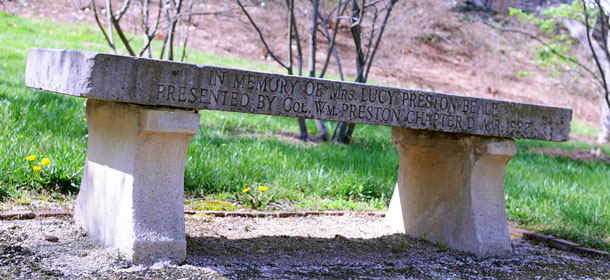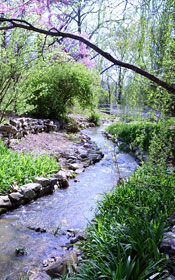The re-greening of the garden

The restoration of Hollins’ Beale Memorial Garden grew from a perfect partnership between the university and the Garden Club of Virginia.
By Jennifer Taylor Hodge M.A.L.S. ’09, excerpted from her M.A.L.S. thesis
In preparation for the Garden Club of Virginia’s selection process, Caroline Greene Donnelly [’62] visited previous restorations in the Roanoke and New River Valleys. …[She] found support among Hollins Board of Trustees [members], and the Chair of the Board, Anna Logan Lawson [’65, M.A. ’70], concurred with the importance of the Beale Memorial Garden as an area that Hollins should emphasize. Lawson notes, “No one thought of the project until Carol said it.” The women kept the idea of the restoration alive by sharing their enthusiasm with other alumnae. In March 2003, the Restoration Committee of the Garden Club of Virginia, along with William Rieley, the club’s landscape architect, visited the Hollins campus and “expressed interest and desire for more information.”
A late-twentieth-century master plan outlined the importance of a restoration of the Beale Memorial Garden. A draft of the plan recommended re-establishing “the historic focus on Tinker Creek, and to restore the Beale Garden within an ecologically sensitive corridor extending from the Theatre/Library Quad through to West Campus Drive and Carvin Creek.” With this encouragement and with Garden Club of Virginia direction, Hollins returned to the idea of an extended garden. The choice of mostly native plants made by Rieley in conjunction with the support of Board of Trustees members like Lee Stuart Cochran [’46] and Garden Club of Virginia Restoration Chair Bessie Carter represented a recognition of a trend toward environmentally sound design. These plant selections deviated from [Albert A.] Farnham’s original [1930] plan but provided an opportunity for the best recreation of the garden possible.
 By late winter of the following year, Hollins and the Garden Club of Virginia began the journey to return the Beale Memorial Garden to its beauty and significance on campus. There was “unanimous approval at the Garden Club of Virginia annual meeting” and the restoration began in the fall of 2005. The club and Hollins sealed their partnership with the signing of a contract. In exchange for funding the restoration, the garden club made three promises and had three major requirements of the school. First, the club required that the garden “must be open to the public on a regular basis, either seasonally, several days a week, or daily, including Historic Garden Week in Virginia”; second, that “further maintenance shall be at the obligation of the owner. Strict adherence to high standards of maintenance is required”; and lastly, “any changes in the landscape design must be approved by the owner and GCV.” In turn the Garden Club of Virginia promised to pay for the restoration, publicize the restoration in a variety of manners in the future, and install a plaque acknowledging the partnership.
By late winter of the following year, Hollins and the Garden Club of Virginia began the journey to return the Beale Memorial Garden to its beauty and significance on campus. There was “unanimous approval at the Garden Club of Virginia annual meeting” and the restoration began in the fall of 2005. The club and Hollins sealed their partnership with the signing of a contract. In exchange for funding the restoration, the garden club made three promises and had three major requirements of the school. First, the club required that the garden “must be open to the public on a regular basis, either seasonally, several days a week, or daily, including Historic Garden Week in Virginia”; second, that “further maintenance shall be at the obligation of the owner. Strict adherence to high standards of maintenance is required”; and lastly, “any changes in the landscape design must be approved by the owner and GCV.” In turn the Garden Club of Virginia promised to pay for the restoration, publicize the restoration in a variety of manners in the future, and install a plaque acknowledging the partnership.
After…years’ worth of work, the restoration culminated in a landscape with reconnected paths, an emphasis on both the creek and native plants, and a renewed sense of identity for the Beale Memorial Garden. …In October 2006, the Garden Club of Virginia and Hollins rededicated the Beale Memorial Garden.
A version of Hodges’ thesis, “Mother Dearly Loved Flowers: The Creation, Evolution, and Restoration of the Beale Memorial Garden at Hollins University,” appeared in The Smithfield Review, Volume XIV, 2010.
Photo: A garden bench engraved in memory of Lucy Preston Beale, for whom the garden is named. Beale attended Hollins for one session, in 1864. Her daughter, Lucy Beale Huffman, class of 1904, helped create the garden in her mother’s memory.
Photo credit: Olivia Body ’08
